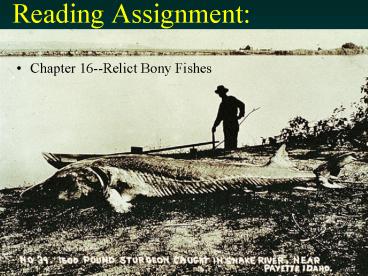Reading Assignment: - PowerPoint PPT Presentation
1 / 36
Title:
Reading Assignment:
Description:
Diffusion, osmosis, pressure, & molecular movement from electrochem. ... unconfirmed reports of carp 200-400 yr. authenticated records for carp 50 yr. ... – PowerPoint PPT presentation
Number of Views:64
Avg rating:3.0/5.0
Title: Reading Assignment:
1
Reading Assignment
- Chapter 16--Relict Bony Fishes
end
2
Passive processes
- Diffusion, osmosis, pressure, molecular
movement from electrochem. Forces are passive
processes - require no energy from organism
- Active Processes-those that require organism to
expend energy. - needed for homeostasis to counter some passive
processes
end
3
Definitions
- Ionic Regulation maintenance of concentrations
of specific ions - Osmoregulation maintenance of constant
concentrations of total dissolved substances in
extracellular fluids
end
4
Four osmoregulatory strategies in fishes
- 1. Isosmotic (nearly isoionic)
- essentially no regulation
- body fluids same osmotic conc. as environment
- advantages and disadvantages?
- Examples many inverts. Hagfishes only marine
spp.
end
5
Four osmoregulatory strategies in fishes
continued
- 2. Isosmotic with regulation of specific ions
- organic salts stored in extracellular fluids
(prim. urea) - Inorganic salt conc. approx. 1/3 seawater
- rectal gland secretes Na and Cl- in conc close
to that of seawater (active process) - advantages and disadvantages?
- Examples elasmobranchs, coelacanth (marine)
end
6
Four osmoregulatory strategies in fishes
continued
- 3. Osmotic ionic regulation by marine teleosts
- ionic conc. Approx 1/3 of seawater
- drink copiously to gain water
- Chloride cells eliminate Na and Cl-
- kidneys eliminate Mg and SO4
- advantages and disadvantages?
- Examples saltwater teleosts
end
7
Saltwater teleosts
H2O
drink
Na, Cl-
Na, Cl-
Mg, SO4
Na, Cl- Mg, SO4
kidneys
chloride cells
end
8
Chloride Cell fig 6.2
sea water
charge
charge
2Cl-
Na
Na K ATPase
K
Na,K
mitochondria
internal (blood)
tubular system
end
9
Four osmoregulatory strategies in fishes
continued
- 4. Osmotic ionic regulation by FW teleosts
- ionic conc. Approx 1/3 of seawater
- dont drink
- Chloride cells fewer, work in reverse
- kidneys eliminate excess water ion loss
- ammonia bicarbonate ion exchange mechanisms
- advantages and disadvantages?
- Examples FW teleosts FW elasmobranchs
end
10
Freshwater teleosts
Ion exchange pumps beta chloride cells
kidneys
end
11
Ion Exchange Mechanisms
freshwater
interior
Na?
active pump
ATP
Cl-?
active pump
ATP
end
12
Freezing Resistance
- What fishes might face freezing?
- hagfishes?
- isotonic
- marine elasmobranchs?
- isotonic
- freshwater teleosts?
- hypertonic
- marine teleosts?
- hypotonic
end
13
Solution for cold-adapted marine teleosts
- Macromolecular antifreeze compounds
- peptides (protein)
- glycopeptides (carbohydrate/protein)
- molecules adsorb to ice crystal surface
- interfere with ice crystal growth
- ice ruptures cells interferes with osmotic
balance
end
14
end
15
Growth
- Longevity
- unconfirmed reports of carp 200-400 yr.
- authenticated records for carp 50 yr.
- large fish-few gt 12-20 yr.
- some marine spp gt 100 yr. thornyspines, orange
roughy - many small spp-2 yr. or less (sardines,
anchovies) - Note aging with scales, bones, otoliths
end
16
end
17
(No Transcript)
18
Growth Other Generalities
- females often larger than males
- growth rate varies with temp.
- longevity inversely proportional to temp.
- stress reduces growth
- dominance hierarchies - dominant get food
- overcrowding can lead to stunting
- indeterminate growth - grow throughout life
- growth highly variable - can loose weight
end
19
Bioenergetic Definition of Growth
- energy accumulation (calories) vs. length or
weight
end
20
Bioenergetics continued
- Energy Budget
- I M G E
- where I ingested energy
- M energy expended for metabolism
- G energy stored as growth
- E energy lost to environment
end
21
Bioenergetic Energy Budget
I
E
end
22
Bioenergetics continued
- Ex M energy for body repair
- maintenance
- activity
- digestion
end
23
Bioenergetics continued
- Ex E energy in feces
- ammonia, or urea
- mucus
- epidermal cells
end
24
Terms
- Standard Metabolic Rate
- maintenance met. no growth, no activity
- Routine Metabolic Rate
- typical met. routine growth activity
- Active Metabolic Rate
- max. aerobic metabolism
end
25
Factors Affecting Growth Temperature
routine
active
standard
scope
Metabolic Rate
activity
growth
Where would growth be best?
Temperature
end
26
Factors Affecting Growth Temperature
normal O2
reduced O2
Metabolic Rate
reduced scope
reduced growth
Temperature
end
27
Growth will not occur at low O2
Ex LMB cease growing below 5 mg/L
end
28
Factors Affecting Growth Dissolved oxygen
Routine Metabolism
critical O2 concentration
Dissolved Oxygen mg/L
end
29
end
30
- The following slides are animated with a feature
that does not work on powerpoint2000. save for
use when 105 gets ppxp - These will replace the diffusion and osmosis
slides above.
end
31
end
32
end
33
(No Transcript)
34
(No Transcript)
35
substance
36
substance































